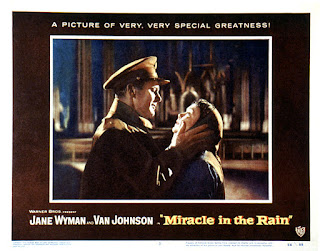 |
| Little Anthony (Billy Mumy) sends someone to the corn field |
IT'S A GOOD LIFE.
Short story by Jerome Bixby 1953.
Twilight Zone episode. 1961. Director: James Sheldon.
Segment in
Twilight Zone --The Movie. 1983. Director: Joe Dante.
"It's Still a Good Life"
Twilight Zone. 2003. Director: Allan Kroeker.
In 1953 author Jerome Bixby came out with a short horror story that was to become a classic. "It's a Good Life" presented a small town with a terrible secret, and a few dozen terrified, hopeless inhabitants all desperately afraid of one person: a frightful mutant little three-year-old boy with God-like powers named Anthony Freemont
. Anthony has isolated the town of Peaksville from the rest of the world, or destroyed the rest of the world -- nobody is certain which. As he can read minds, everyone is terrified of having any negative thoughts about the boy or the "good" life in Peaksville, as Anthony can hear them and wreak a terrible vengeance, turning people he doesn't like into hideous creatures and mentally dispatching them to instant burial in the cornfield. Anthony is too young to understand adult feelings or even know the difference between right and wrong, and can turn on anyone on a dime. The story is a masterpiece of despair.
"It's a Good Life" was adapted
for both television and film, and a sequel was also presented years later. None of the adaptations address the fact that Bixby's story sort of implies that Anthony does not exactly look like a normal human child, as his doctor tries to kill him the moment he comes out of the womb. They also make Anthony several years older than he is in the story. The older Anthony is not just cruel in the way of many little boys, but rather
sadistic and possibly sociopathic. One senses he won't develop
compassion as he gets older, if for no other reason than his parents are
afraid to discipline him.
"It's a Good Life" was first adapted for the third season of
The Twilight Zone in 1961. 7-year-old adorable Billy Mumy was cast as Anthony, and did a very good job as the child-monster, with excellent support from such estimable performers as Cloris Leachman and John Larch as his parents, and Don Keefer as one of his victims [with Jeanne Bates as Keefer's nearly apoplectic wife]. Rod Serling's script, in addition to making Anthony four years older, made two notable contributions to the story, both revolving around Keefer's character, Dan Hollis. As a drunken Hollis prepares to face the wrath of Anthony, he screams at the others to take advantage of the child's distraction and bash his brains in ["Won't anybody
end this?!], but -- horribly -- no one can quite do it [although one woman comes close.] Let down by his fellow travelers-in-nightmare, Hollis is transformed into a jack-in-the-box with a human head [Bixby doesn't say what he's been turned into in the story, only something dreadful]. "It's a Good Life" is one of the most memorable
Twilight Zone episodes ever produced.
A new version of the story appeared as one of four segments of
Twilight Zone: The Movie in 1983. Joe Dante directed a kind of black comedy version of the story. Peaksville is no longer isolated, and the segment introduces the new character of a teacher, Helen (Kathleen Quinlan), who has just arrived in town. When we're first introduced to Anthony (Jeremy Licht), he seems like a normal little boy who doesn't even use his power against a grown-up bully in a restaurant. Helen runs into Anthony's bike and drives him home, where she meets his nutty family, and Helen slowly realizes the truth. Although this version of the story is definitely the least memorable, it does have some interesting aspects. This Anthony, who lives in a different era, probably
would be addicted to cartoons and the like and make his family inhabit a cartoon-like world, which would, in all probability, drive them crazy. The excellent special effects include a monster rabbit that Anthony's uncle unwittingly pulls out of his hat, and the sequence when Anthony puts his sister, Ethel (Nancy Cartwright), into a cartoon playing on television. Patricia Barry, William Schallert and Kevin McCarthy and the others all give good performances for this manic, silly version of Bixby's classic, which is almost unrecognizable.
In 2003 on a new
Twilight Zone series there was a sequel to the story entitled "It's Still a Good Life." In this forty years have passed and Anthony [still played by Bill Mumy in a casting coup] is a full-grown psychopath still holding the isolated town of Peaksville in his thrall, and still sadistically killing anyone who displeases him. He has sent both his father and his wife to the cornfield, and has a little girl, Audrey (played by Mumy's own daughter, Liliana.) His mother [again Cloris Leachman in an outstanding performance] discovers that Audrey has powers of her own, and hopes to enlist her in consigning her father to oblivion in the corn field. "If only I'd been strong enough, brave enough, to bash his head in years ago," she says. Unfortunately, things don't work out the way she hopes, and "It's Still a Good Life," scripted by Ira Steven Behr, becomes, if anything, even more chilling and hopeless than the original.
Verdicts: Original story: ****.
Twilight Zone 1961. ***1/2.
Twilight Zone 2003: ***1/2.
Twilight Zone: The Movie: **1/2.

























